Council tax reduction in Scotland: 2016-2017
Provides statistics on the Council Tax Reduction (CTR) scheme, which reduces the council tax liability of low-income households in Scotland.
This document is part of a collection
2. Number of CTR recipients
The number of recipients for each local authority in January, February and March 2017 is shown in Table 2. The total number of recipients in Scotland decreased from 490,410 in December 2016 to 487,490 in January 2017. The number then increased over the next two months to 491,760 recipients in March 2017.
Table 2: CTR Recipients by Local Authority, January to March 2017 1, 2
| Jan-17 | Feb-17 | Mar-17 | |
|---|---|---|---|
| Scotland | 487,490 | 489,070 | 491,760 |
| Aberdeen City | 13,930 | 14,020 | 14,130 |
| Aberdeenshire | 11,580 | 11,600 | 11,870 |
| Angus | 8,690 | 8,730 | 8,780 |
| Argyll and Bute | 6,920 | 6,950 | 7,000 |
| Clackmannanshire | 5,230 | 5,230 | 5,300 |
| Dumfries and Galloway | 13,140 | 13,190 | 13,260 |
| Dundee City | 18,180 | 18,210 | 18,230 |
| East Ayrshire | 13,570 | 13,590 | 13,680 |
| East Dunbartonshire | 5,450 | 5,450 | 5,500 |
| East Lothian | 7,010 | 6,970 | 6,980 |
| East Renfrewshire | 4,600 | 4,590 | 4,610 |
| Edinburgh, City of | 34,630 | 34,740 | 35,660 |
| Eilean Siar | 2,380 | 2,360 | 2,400 |
| Falkirk | 13,500 | 13,470 | 13,520 |
| Fife | 31,280 | 31,460 | 31,460 |
| Glasgow City | 90,400 | 90,570 | 90,860 |
| Highland | 17,260 | 17,480 | 17,630 |
| Inverclyde | 9,710 | 9,730 | 9,770 |
| Midlothian | 6,680 | 6,660 | 6,690 |
| Moray | 5,820 | 5,910 | 5,900 |
| North Ayrshire | 17,120 | 17,250 | 17,360 |
| North Lanarkshire | 36,790 | 36,870 | 36,870 |
| Orkney Islands | 1,240 | 1,240 | 1,240 |
| Perth and Kinross | 9,020 | 9,050 | 9,130 |
| Renfrewshire | 18,350 | 18,400 | 18,450 |
| Scottish Borders | 8,660 | 8,780 | 8,720 |
| Shetland Islands | 1,060 | 1,080 | 1,070 |
| South Ayrshire | 11,330 | 11,360 | 11,420 |
| South Lanarkshire | 30,640 | 30,680 | 30,790 |
| Stirling | 5,740 | 5,730 | 5,670 |
| West Dunbartonshire | 12,640 | 12,600 | 12,680 |
| West Lothian | 14,990 | 15,110 | 15,160 |
Notes:
1 Recipients are as at monthly count date. See Methodology Notes, Section 2 for more details.
Available at http://www.gov.scot/Topics/Statistics/Browse/Local-Government-Finance/Methodology/Ctaxreductionmethod
2 Figures are rounded to the nearest 10. Components may not sum to total due to rounding.
In March 2017, the five local authorities with the highest numbers of CTR recipients accounted for almost half (46 per cent) of the total for Scotland. Glasgow City accounted for the highest proportion, with 18 per cent (90,860 recipients) of the total; followed by North Lanarkshire, accounting for 7 per cent (36,870 recipients); Edinburgh City, accounting for 7 per cent (35,660 recipients); and Fife and South Lanarkshire, accounting for 6 per cent each (31,460 and 30,790 recipients respectively).
The three island local authorities had the smallest share of the caseload with only 0.5 per cent in Eilean Siar (2,400 recipients) and Orkney and Shetland accounting for 0.2 per cent each (1,240 and 1,070 recipients respectively).
Figure 3 shows CTR recipients by local authority for March 2017 in a treemap. This allows a visual comparison of the number of recipients in each local authority.
Figure 3: Treemap of CTR recipients, March 2017
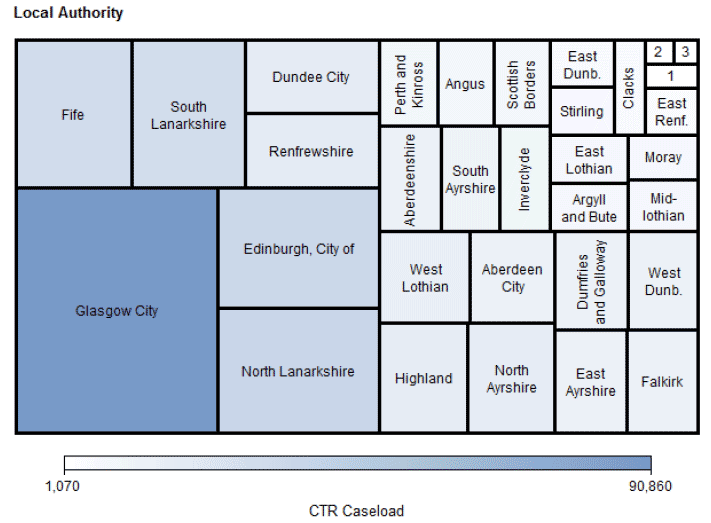
Key:
1 = Eilean Siar
2 = Orkney Islands
3 = Shetland Islands
Clacks = Clackmannanshire
East Dunb. = East Dunbartonshire
East Renf. = East Renfrewshire
West Dunb. = West Dunbartonshire
2.1 CTR recipients over time
The number of households receiving CTR in Scotland fell from 552,380 in April 2013 to 491,760 in March 2017, a decrease of 11 per cent (60,620 recipients). Chart 1 shows the downward trend in the number of recipients over this period.
All local authorities in Scotland have seen a decrease in the number of CTR recipients since the scheme was introduced in April 2013. Chart 2 shows the percentage change between April 2013 and March 2017 for all local authorities in Scotland.
Chart 2: Percentage decrease in CTR recipients by local authority, April 2013 to March 2017
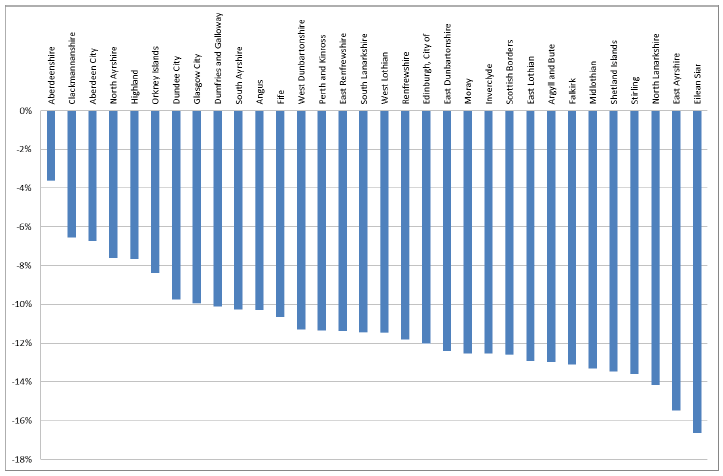
The largest percentage decreases in number of recipients were seen in Eilean Siar (16.6 per cent), East Ayrshire (15.5 per cent) and North Lanarkshire (14.2 per cent). Whilst Eilean Siar had relatively a large percentage decrease, this represents a relatively small number of recipients. The smallest decreases were seen in Aberdeenshire (3.6 per cent) Clackmannanshire (6.5 per cent) and Aberdeen City (6.7 per cent).
The number of recipients for each local authority for each month between April 2016 and March 2017 are provided in the supplementary tables.
2.2 CTR recipients by passported status
In March 2017, passported recipients accounted for 66 per cent of all CTR recipients. The most common passporting benefits were income-related Employment and Support Allowance and Pension Credit (Guarantee Credit) which made just over half of all CTR recipients. The majority of non-passported recipients were not in employment.
Chart 3: CTR recipients by passported status, March 2017
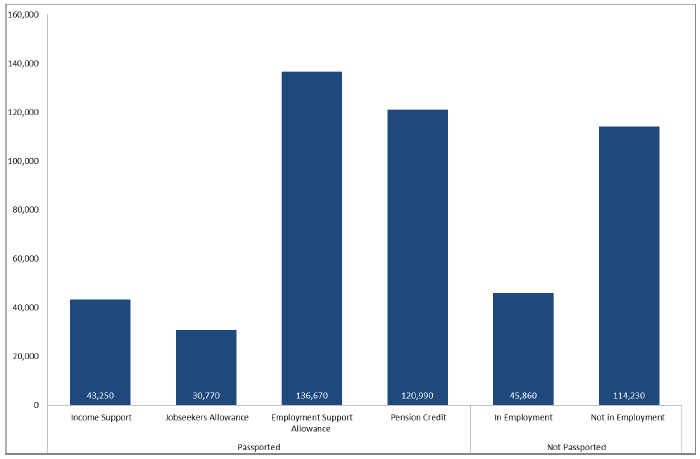
The number of recipients by passported status and local authority in March 2017 is available in the supplementary tables. Some key variations across local authorities are:
- East Ayrshire & Glasgow had the highest proportion of passported CTR recipients (72 per cent).
- East Lothian and Highland had the lowest proportion of passported CTR recipients (at 55 per cent and 59 per cent respectively). These Local Authorities were the first in Scotland to be involved in the 'Full Service' roll-out of Universal Credit.
The number of recipients by passported status for April 2016 to March 2017 is available in the supplementary tables. The figures show that the number of passported CTR recipients has decreased whereas the number of non-passported recipients increased.
It should be noted that Universal Credit ( UC) recipients are categorised as non-passported as their CTR award is based on the income assessment figures calculated during their UC application. As the roll-out of UC continues, the proportion of CTR cases classed as non-passported will increase.
2.3 CTR recipients by age and family type
Chart 4 shows the number of CTR recipients by age group in March 2017. The age group with the highest proportion of CTR recipients was 65 or over, at 38 per cent (184,470 recipients). The age group with the lowest proportion were those under 25 at four per cent (19,790 recipients).
Chart 4: CTR recipients by age group, March 2017
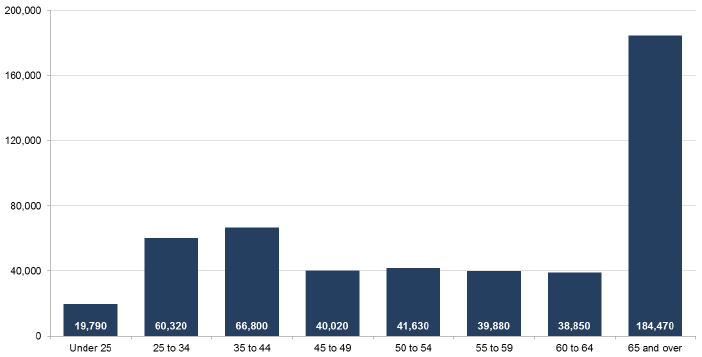
Chart 5 shows the number of CTR recipients by family type in March 2017. The majority of CTR recipients (66 per cent) were single with no child dependent. Lone parents made up almost 16 per cent, and just under one-fifth were couples.
Chart 5: CTR recipients by family type, March 2017
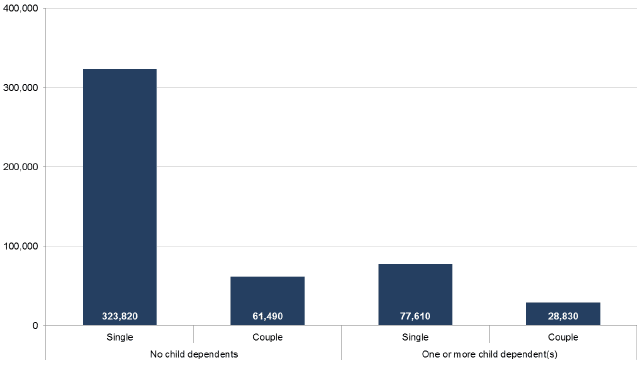
2.4 CTR recipients by deprivation
The Scottish Index of Multiple Deprivation ( SIMD) 1 is the Scottish Government's official tool for identifying those places in Scotland suffering from deprivation. It divides Scotland into 6,976 datazones, each containing around 350 households or an average of 760 people. Each datazone has a calculated 'deprivation score' and these scores are then used to rank the datazones. Decile 1 contains the ten per cent most deprived datazones, Decile 2 the next ten per cent most deprived, and so on.
It should be noted that the overall SIMD score assesses deprivation across seven domains - income, employment, health, education, housing, geographic access to services and crime. The CTR scheme is principally concerned with income and family circumstances as a basis for making awards (see Table 1 above).
Chart 6 shows the spread of CTR recipients across areas of deprivation using SIMD deciles as described. It can be observed that CTR recipients are heavily concentrated in areas of highest deprivation, with 50 per cent of recipients (245,470) in the lowest three deciles in March 2017.
Chart 6: CTR recipients by SIMD decile, March 2017
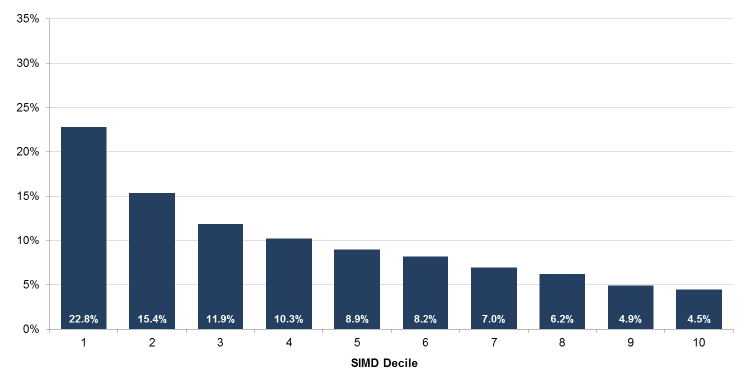
2.5 Full and partial CTR
Full CTR refers to recipients whose Council Tax liability is reduced to zero. Partial CTR refers to recipients whose Council Tax liability is reduced, but they are still liable to pay part of the total. Further details on these terms and how CTR is calculated are given in Section 1.1.
In March 2017, around two-thirds of CTR recipients (323,970) had been awarded full CTR as they were also in receipt of a passporting benefit. The other third of recipients underwent an income assessment. Following this a further twelve per cent of recipients (59,280) were awarded full CTR and the remainder (108,510 recipients) were awarded partial CTR.
Of all CTR recipients, over three-quarters (383,250) were in receipt of full CTR in March 2017.
Chart 7: CTR recipients by full or partial award, March 2017
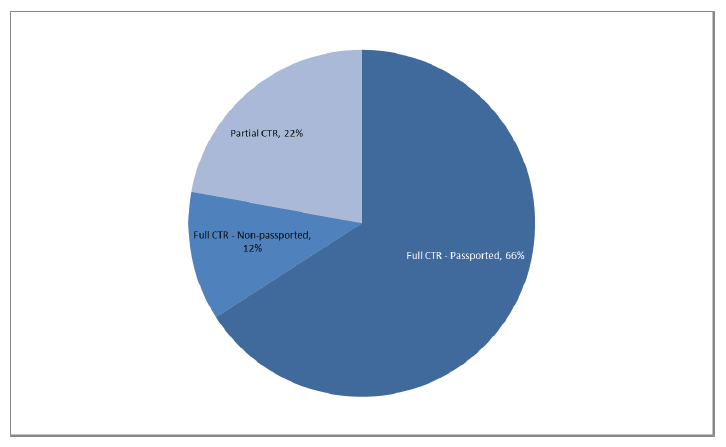
Contact
There is a problem
Thanks for your feedback